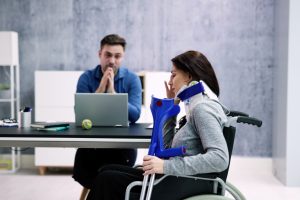Brad Andringa, an experienced veterans’ disability attorney, shares more about veterans’ disability benefits and their underlying legislation in this feature.
Veterans’ disability law plays a vital role in ensuring that those who served their country receive the benefits and support they deserve. This body of law aims to provide compensation and support to veterans who have suffered disabilities as a result of their military service.
The key legislation that forms the basis of veterans’ disability law in the United States is the Veterans Benefits Act of 1957, which established the Department of Veterans Affairs (VA) and created a system to provide disability benefits to eligible veterans. Over the years, additional laws have been passed to expand and refine the benefits available to disabled veterans.
The VA operates the Veterans Benefits Administration (VBA), which is responsible for evaluating disability claims and determining eligibility for compensation and other benefits. To qualify for disability benefits, a veteran must demonstrate that their disability or medical condition is service-connected, meaning it was caused or aggravated by their military service.
Service connection in veterans’ disability benefits refers to the link established between a veteran's current medical condition or disability and their military service. It is a critical requirement for veterans seeking compensation and healthcare benefits from the VA. Service connection recognises that a veteran's disability or illness is a result of an injury, disease, or event that occurred during their active duty, active duty for training, or inactive duty for training.
Veterans separate from military service with a myriad of issues that can be immediate, including disabilities such as loss of limbs or injuries from combat. However, disabilities can also arise decades later after veterans experience harmful exposures during military service, including herbicides such as Agent Orange; burn pits; contaminated water at Camp Lejeune, NC; asbestos on Naval ships; ionising radiation; and firefighting foams commonly known as aqueous film-forming foam (AFFF).
Service connection recognises that a veteran's disability or illness is a result of an injury, disease, or event that occurred during their active duty, active duty for training, or inactive duty for training.
Agent Orange was a herbicide widely used by the US military during the Vietnam War. It contained a toxic chemical called dioxin, which has been linked to various health conditions. Recognising the adverse effects of Agent Orange exposure, Congress has passed several laws to provide benefits and medical care to veterans who were exposed to this herbicide. The VA operates on a ‘presumption of service connection’ for certain health conditions associated with Agent Orange exposure. This means that if a veteran served in Vietnam or in certain other locations during specific periods and develops any of the designated conditions, they are presumed to be related to their military service. Some of the recognised conditions include type 2 diabetes, certain types of cancers (e.g. prostate cancer, lung cancer), Parkinson's disease and ischemic heart disease.
In 2022, Congress passed the Sergeant First Class Health Robinson Honoring our Promise to Address Comprehensive Toxics (PACT) Act, adding more than 20 presumptive disabilities for Agent Orange, burn pits and other toxic exposures. The PACT Act is perhaps the largest healthcare and benefits expansion in VA history.
The most common disabilities we encounter are mental health conditions including depression, anxiety and post-traumatic stress (PTSD). Mental health conditions can be directly related to stressful or traumatic events during military service, or as a result of an already service-connected physical disability. Secondary service connection is a concept within veterans’ disability law that allows veterans to receive compensation for disabilities that are not directly caused by their military service but are linked to a service-connected condition. For example, veterans are often limited in their activities of daily living due to pain, which can have a dramatic effect on veterans’ mental health. Also, common side effects of an in-service traumatic brain injury (TBI) include behavioural and cognitive changes, which are often separately rated as mental health conditions.
One of the unique aspects of veterans’ disability law is the veteran-friendly burden of proof: ‘at least as likely as not’ (50/50). Although veterans bear the burden of proof, when there is an approximate balance of positive and negative evidence regarding any issue material to the determination of a claim, the VA must afford the benefit of the doubt to the veteran.
The most common disabilities we encounter are mental health conditions including depression, anxiety and post-traumatic stress (PTSD).
Once the veteran provides evidence sufficient to satisfy the elements for service connection, the VA must grant service connection and assign a disability rating and effective date. The VA assigns a disability rating to each eligible condition, ranging from 0% to 100% in increments of 10%. The rating reflects the severity of the disability and determines the amount of compensation the veteran will receive. Higher ratings indicate more significant disabilities. The amount of compensation is based on the veteran's disability rating. The VA provides a chart that specifies the monthly payment rates corresponding to each rating. As of 2023, the rates start at around $166 per month for a 10% disability rating and approximately $3,621 per month for a 100% disability rating.
Veterans who are unable to secure substantial employment due to their service-connected disabilities may be eligible for individual unemployability benefits. This program provides compensation at the 100% rate, even if the veteran's disability rating is below that level.
Lastly, the VA must determine the effective date of an award – the starting point from which the VA calculates the payment of disability benefits. The effective date is of great significance because it plays a crucial role in determining the amount of retroactive benefits a veteran may receive. Retroactive benefits are the payments that cover the period from the effective date to the date of the award decision. If a veteran's effective date is established several years before the date of the award decision, they may be entitled to a significant amount of retroactive benefits.
Under current VA law, attorney fees may be charged on an hourly basis, flat fee, or contingent fee basis, or a combination of all three. However, contingency fees are most common because many veterans and their families are unable to pay for legal services up front. Also, with the length of time disability claims take to resolve, it is not practical to charge on an hourly basis. The VA’s regulations provide that fees which do not exceed 20% of any past-due benefits awarded shall be presumed to be reasonable, and fees exceeding 33.3% of any past-due benefits awarded shall be presumed unreasonable. It can take the VA more than a year to review an attorney fee for reasonableness, so many attorneys charge a contingency fee for 20% of past-due benefits to avoid delayed payment.
There are also limitations on when attorneys may charge a fee – once the VA makes an initial decision, only then may a fee be charged for services provided. In practice, the most desirable cases have had a decision in the last 12 months, because the time limit to appeal a VA decision is one year. Veterans may pursue VA claims forever so long as an appeal is filed within one year of the previous decision. This is where our services come into play. We are often able to save veterans years off their cases by being intentional with the appeals we file and developing the necessary evidence.
Once the VA makes an initial decision, only then may a fee be charged for services provided.
When we take a new case, we explain that there our representation is really broken down into two parts: 1) we develop the evidence and argument to satisfy the VA’s requirements for benefits and 2) we navigate the bureaucracy of administrative law at the VA level. It can be immensely frustrating to present the perfect evidence and argument only for the VA to continuously deny a claim for reasons that cannot be found anywhere in the VA’s own regulations. Therefore, it is a constant battle to move through the VA’s appeal process as efficiently as possible to reach a favourable outcome. Even when the VA grants service connection for a claimed disability, the assigned disability ratings and effective dates are often incorrect, which requires additional appeals.
In 2019, the VA enacted the Appeals Modernization Act (AMA), which is an appeal process intended to provide veterans with a more streamlined and efficient way to appeal disability claims decisions. Here is a summary of the key steps involved in the AMA appeal process:
- Supplemental Claim Lane: In this lane, veterans can submit new and relevant evidence to support their claim. The VA will review the new evidence and make a new decision. If dissatisfied, veterans can proceed to the next lane.
- Higher-Level Review Lane: In this lane, veterans can request a higher-level review by a more experienced VA reviewer. The higher-level reviewer will take a fresh look at the claim and their review is limited to the evidence already in the record at the time of the previous decision. This is the fastest appeal route and is very useful for correcting incorrect disability ratings and effective dates.
- Board of Veterans' Appeals (BVA) Lane: If dissatisfied with the decision in the previous lanes, veterans can appeal to the BVA and a Veterans Law Judge will render a decision. This is the highest-level decision maker at the VA.
The number one complaint we hear about veterans’ disability benefits from clients and other representatives is the length of time the VA takes to decide claims. The VA reports that their goal is to decide Supplemental Claim and Higher-Level Review appeals in 125 days on average. For a decision from the BVA, the VA’s goal is to decide cases in 365 days, or longer if a veteran requests a hearing or to submit additional evidence.
Although the VA typically issues Higher-Level Review decisions in fewer than 125 days, the other appeal options usually take a lot longer than projected. When explaining the appeal options to our clients, we generally project anywhere from two months to a year for a Supplemental Claim and at least two years for a decision from a Veterans Law Judge.
Many clients still have claims that are moving through the VA’s older legacy appeal process. The VA’s website reports that when a veteran requests review from a Veterans Law Judge at the BVA, it could take five to seven years to get a decision.
In practice, it is difficult to explain these wait times to a new client, and it is even harder to explain as the years tick by and their disabilities worsen, the medical bills pile up and their ability to maintain full-time employment diminishes. We also explain that this is the only way to obtain veterans disability benefits from the VA, and it is in the VA’s best interest if we give up and stop fighting.
Our goal is to take on the stress and frustration of pursuing veterans disability compensation benefits. I remind our clients that we have a shared interest in ensuring their cases are decided as favourably and quickly as possible. We never want our clients to think that we have any part in how long the appeal process takes, so like any other practice area, it is helpful to provide regular updates and maintain open lines of communication. I have also learned that managing expectations is a process and not something that can be done once at the outset of representation.
Many clients still have claims that are moving through the VA’s older legacy appeal process.
I realise that we can never fully understand what is like to be in our clients’ shoes, but it is important that we listen and try to understand. Empathy may be the most important attribute for success in this field. But without establishing healthy boundaries, it can also lead to burnout very quickly.
Unfortunately, we are representing more and more surviving spouses of deceased veterans. In certain cases, dependents of disabled veterans or surviving spouses and children of deceased veterans may be eligible for additional benefits, such as Dependency and Indemnity Compensation (DIC) or the Survivors' and Dependents' Educational Assistance (DEA) program. Surviving spouses may also be entitled to substitution benefits which are provided to compensate the spouse of a deceased veteran for the loss of the veteran’s disability benefits. By substituting into a claim, the surviving spouse is able to pursue pending claims at the time of the veteran’s passing.
About Brad Andringa
For as long as I can remember, I always wanted to be a lawyer. My father was a state trial court judge, and my mother was a prosecutor, both in Pinellas County, Florida. I also had two brothers growing up – one was a lawyer and the other was a helicopter pilot in the Army. I wanted to be just like my brothers. I followed their footsteps and went to Florida State University and earned an undergraduate degree in economics. Then I attended the University of Dayton School of Law. When I graduated law school, I honestly did not have any idea what I wanted to do, but I needed a job. When Horenstein, Nicholson & Blumenthal, LPA interviewed me for the veterans’ disability position, it clicked. I immediately got along with the partners of the firm, and they were incredible mentors.
When I graduated, I thought my two options were transactional or litigation work. But veterans’ disability law requires so many of the skills taught in law school. We speak with clients, doctors and adjudicators. We also draft briefs, memoranda and letters. We review medical records and conduct legal research. I love that we get to do a little bit of everything to help our clients obtain the disability benefits they are entitled to.
Brad Andringa, Attorney
Horenstein, Nicholson & Blumenthal, LPA (HNB Law)
124 East 3rd Street Fifth Floor, Dayton, OH 45402, USA
Tel: +1 888-281-5930
Brad Andringa has been an attorney at HNB law for more than five years, drawn by the firm’s commitment to professionalism and working compassionately with clients. His practice focuses on veterans’ disability benefits, drawing from a versatile background of experience in the public, private and non-profit sectors.
HNB Law is an injury, employment and disability law firm based in Ohio. Its team covers a range of practice areas including Social Security, veterans’ disability, personal injury, workers’ compensation and employment law matters.





















